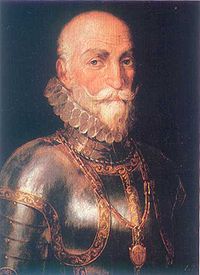- Álvaro de Bazán, 1st Marquis of Santa Cruz
-
This article is about the 16th century Spanish admiral. For other uses, see Álvaro de Bazán (disambiguation).
Álvaro de Bazán 
Born December 12, 1526
Granada, SpainDied February 9, 1588 (aged 61)
Lisbon, PortugalAllegiance Spain Service/branch Navy Rank Admiral Álvaro de Bazán, 1st Marquis of Santa Cruz de Mudela (December 12, 1526 – February 9, 1588), was a Spanish admiral.
Biography
Álvaro de Bazán was born in Granada.
His grandfather, Álvaro de Bazán, took part in the conquest of Granada in 1492, and his father took part together with Giovanni Andrea Doria and others marines in the recapture of Tunis in 1535, and was distinguished in the service of Charles V, by whom he was made general of the galleys or commander-in-chief of the Spanish naval forces in the Mediterranean.
The future admiral followed his father in his youth, and was employed in the high command of the Spanish navy at a fairly early age. He was a member of the Military Order of Santiago (St. James). In 1564, he aided in the capture of Peñón de Vélez de la Gomera, and commanded the division of galleys employed to blockade Tetuan, and to suppress the piracy carried on from that port. The service is said to have been successfully performed. Bazán certainly earned the confidence of Philip II, by whom he was appointed to command the galleys of Naples in 1568. This post brought him into close relations with John of Austria, when the Holy League was formed against the Turks in 1570.
During the operations which preceded and followed the Battle of Lepanto (7 October 1571), Bazán was always in favor of the more energetic course. In the battle he commanded the reserve division, and his prompt energy averted a disaster when Uluj Ali, who commanded the left wing of the Turks, outmaneuvered the commander of the Christian right, Gian Andrea Dorea, the nephew of his old comrade Andrea Doria, and broke the Allied line. He accompanied Don John of Austria at the taking of Tunis in the following year.
 National Record Office of Spanish Navy, located in Santa Cruz Palace - Viso del Marqués- Spain.
National Record Office of Spanish Navy, located in Santa Cruz Palace - Viso del Marqués- Spain.
When Philip II enforced his claim as heir to the crown of Portugal in 1580-1581, Santa Cruz held a naval command. But António, Prior of Crato, an illegitimate representative of the former Portuguese royal family, who conducted some popular resistance to the crowning of what was seen as a foreign king, continued to hold the islands of the Azores. António was supported by a number of French adventurers under Philip Strozzi, a Florentine exile in the service of France. Santa Cruz was sent as "Admiral of the Ocean" to drive the pretender and his friends away in 1583. Badly outnumbered, he won the Battle of Ponta Delgada off Terceira Island against a loose confederation of Portuguese, French, English and Dutch adventurers and privateers, which decided the struggle for the Azores in favor of the Spanish Habsburgs.
Santa Cruz, who recognized that England presented a grave threat to Spain's empire, became a zealous advocate of war. A letter written by him to King Philip from Angra do Heroísmo in Terceira, on August 9, 1583, contains the first definite suggestion of the Spanish Armada.
Santa Cruz himself was to have commanded. His plans, schemes and estimates occupy a conspicuous place in the documents concerning the Armada collected by Don Cesário Duro. The hesitating character of the king, and his many embarrassments, political and financial, caused many delays, and left Santa Cruz unable to act with effect. He was at Lisbon without the means of fitting out his fleet, when Francis Drake burnt the Spanish ships at Cádiz during his 1587 expedition. The independence of judgment shown by Santa Cruz ended by offending the king, and he was held responsible for the failures and delays which were the result of the bad management of his master. His death, which occurred on February 9, 1588 at Lisbon, was said to have been hastened by the unjustified reproaches of the king.
The great galleons employed to carry the trade between Cadiz in Spain and Vera Cruz in Mexico were the joint creation of the Marquis de Santa Cruz and Pedro Menéndez de Avilés.[1]
The documents relating to the Spanish Armada have been collected by Don Cesáreo Fernández Duro in La Armada Invencible, and he gives a biography of the marquis in his Conquista de las Islas Azores. A separate life has been published by Don Ángel de Altolaguirre. There are various notices of Santa Cruz in Sir W. Stirling Maxwell's Don John of Austria.
Several ships of the Spanish Navy were named Álvaro de Bazán in his honour. Currently, a new class of frigates is being built for the Spanish Navy, and the lead ship is the Álvaro de Bazán (F101).
References
- ^ Menéndez: Pedro Menéndez de Avilés, Captain General of the Ocean Sea By Albert C. Manucy Published 1992 by Pineapple Press, Inc. p.100
 This article incorporates text from a publication now in the public domain: Chisholm, Hugh, ed (1911). Encyclopædia Britannica (11th ed.). Cambridge University Press.
This article incorporates text from a publication now in the public domain: Chisholm, Hugh, ed (1911). Encyclopædia Britannica (11th ed.). Cambridge University Press.
Categories:- 1526 births
- 1588 deaths
- People from Granada
- Spanish nobility
- Marquesses of Santa Cruz
- Knights of Santiago
- Spanish admirals
- Anglo-Spanish War (1585–1604)
Wikimedia Foundation. 2010.

